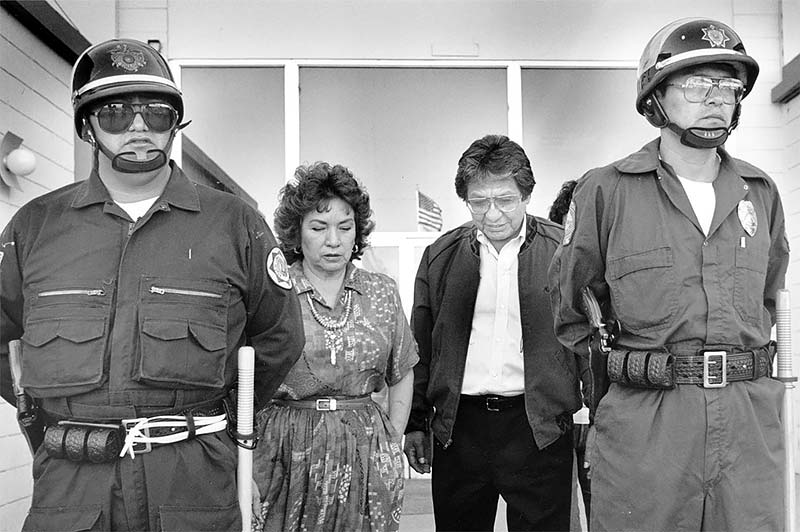
50 years ago: MacDonald envisions a booming Navajo economy

Navajo Times/Paul Natonabah Navajo Nation President Peter MacDonald (1970-1989) walks away from one of his hearings with his wife, Wanda, guarded by Navajo Nation police.
The future Chairman of the Navajo Tribe, Peter MacDonald, took center stage in late March 1967 with his efforts to solve the problems of small businesses on the Navajo Reservation.

Navajo Times/Paul Natonabah
Navajo Nation President Peter MacDonald (1970-1989) walks away from one of his hearings with his wife, Wanda, guarded by Navajo Nation police.
As director of the Office of Navajo Economic Opportunity, the promotion of small businesses was one of the things his agency was supposed to focus its attention on so it came as no surprise when members of the U.S. House Small Business Community wanted to hear what he had to say about why there were so few small businesses on the reservation and most of them were owned by non-Navajos.
There were still more than 70 trading posts on the reservation in 1967, but the days of the trading post were definitely ending as more than 50 trading posts had closed their doors within the last decade.
With the exception of Fed Mart, a general grocery store that had opened in Window Rock during Raymond Nakai’s administration, most Navajo families still did their weekly shopping by heading to the nearest border town.
But MacDonald told committee members that things were changing. Where once Navajos who wanted to start their own business experienced hopelessness, they now felt hopeful.
He gave committee members a picture of a changing reservation environment for those who wanted to start their own business.
“Many Navajos who could never have hoped to own their own business or to enlarge a tiny struggling business have now become self-sufficient,” he said, crediting an ONEO program that had given business loans during the previous year of some $145,000.
But he told the committee that he had been told by officials of the U.S. Office of Economic Opportunity that the program would not be funded until after June 30, three months away.
He explained to committee members that the average Navajo family lived on an income of $700 a year at a time when the BIA pours in some $40 million a year to fund programs to benefit reservation families.
MacDonald said his goal was to create a business environment where Navajo families could shop at a grocery store owned by a Navajo who would hire a Navajo to do repair work on his home and this Navajo would then go to a Navajo barber to get his hair cut in a Navajo-owned barbershop located on the reservation.
This can be done, he said, with the government’s help in providing small business loans to Navajos who qualify.
The picture MacDonald painted of changing conditions was, of course, sugarcoated, because a lot of Navajos experienced many problems trying start up small businesses in 1967. Problems such as bureaucratic red tape, lack of funding, and competition from businesses off the reservation that continues to exist to some extent or other even to this day.
And MacDonald’s dream of a robust Navajo business economy is still pretty much of a dream today although they have been some headway with Navajos opening fast food restaurants and other businesses in major communities and the tribe is still working to build shopping centers in a number of big and small remote Navajo communities.
One thing that MacDonald said got a lot of play back in 1968 – the average Navajo family living on $700 a year.
Even by 1967 standards this was a low amount with the minimum wage at $1.50 an hour or about $3,000 a year.
The figures probably came from the BIA, which at that time did an annual survey of salaries on the reservation and estimated income for Navajos who raised cattle or sheep.
It wasn’t until the late 1970s that the percentage of Navajos who had salaried jobs went over those that didn’t reach 50 percent so reliable figures on Navajo family income was hard to get, especially when considering the underground income that many families relied on to pay their bills.
Income centered on the arts and crafts industry, which probably brought in millions of dollars to Navajo families and was largely unreported to government officials.
It wasn’t until the early 1980s that the Internal Revenue Service started to get tough on Navajos to start reporting this income on their taxes and after making no inroad, the IRS finally got smart and put the burden on the businesses that bought the arts and crafts items, requiring them to keep records of who they paid and how much they paid.
And finally, this was the month when the Navajo Times first became aware of a controversy that would go on for decades – how the State of Utah was spending money which derived the tribe’s share of oil and gas royalties for companies operating on the Utah portion of the reservation.
The agreement called for the companies to pay 37.5 percent in royalties to the state, which on paper, was supposed to be used for projects on the Utah portion of the reservation to benefit the Navajos living thereon.
The problem was that state officials didn’t exactly know how to spend the money and by March 1967 the trust fund was more than $5 million and growing.
Officials in the Aneth area had been complaining for more than a year that the money was desperately needed to improve the quality of life for Utah Navajos but the state refused to spend it.
State officials said that the law was too restrictive on how the money could be spent and there was a fear if the state approved something that was outside these restrictions, the state could be held liable so until the matter was resolved, the state would make no decision.








 Highway 264,
Highway 264, I-40, WB @ Winslow
I-40, WB @ Winslow